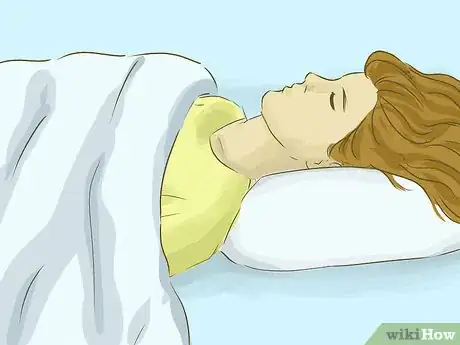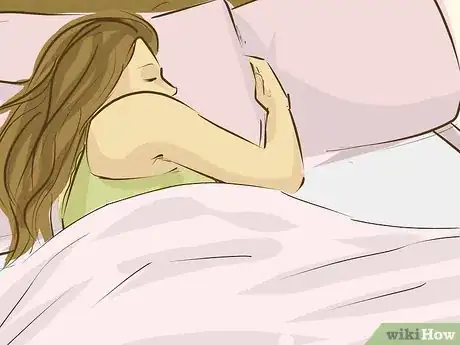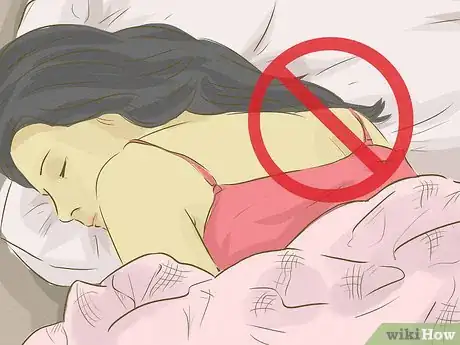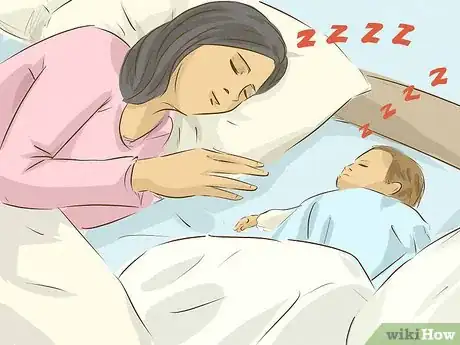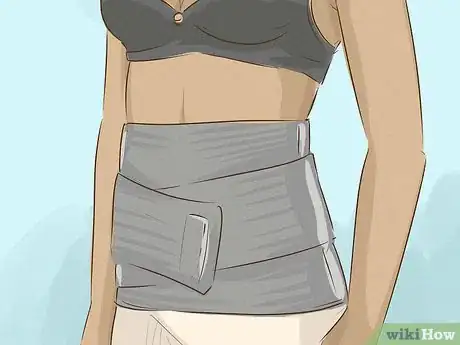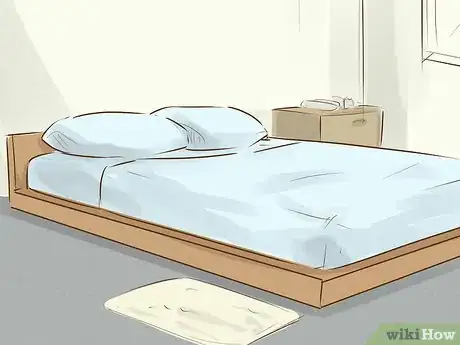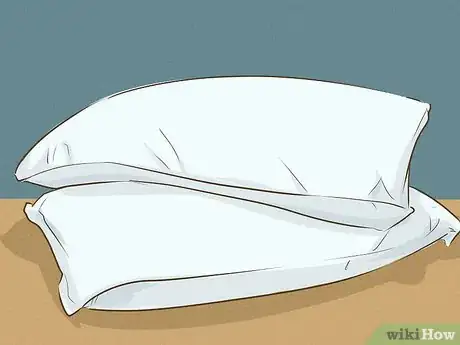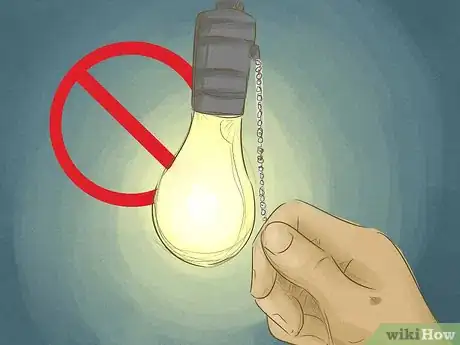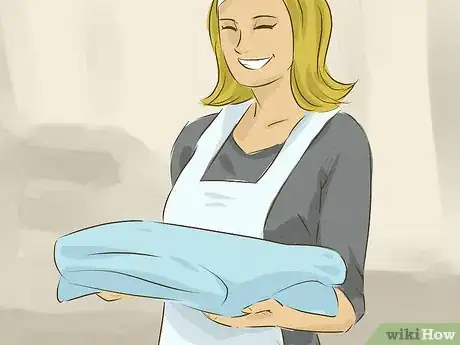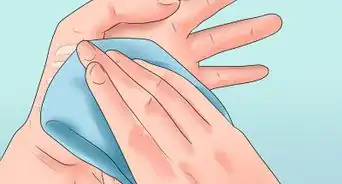This article was co-authored by Rebecca Levy-Gantt, MPT, DO. Dr. Rebecca Levy-Gantt is a board certified Obstetrician and Gynecologist running a private practice based in Napa, California. Dr. Levy-Gantt specializes in menopause, peri-menopause and hormonal management, including bio-Identical and compounded hormone treatments and alternative treatments. She is also a Nationally Certified Menopause Practitioner and is on the national listing of physicians who specialize in menopausal management. She received a Masters of Physical Therapy from Boston University and a Doctor of Osteopathic Medicine (DO) from the New York College of Osteopathic Medicine.
There are 10 references cited in this article, which can be found at the bottom of the page.
This article has been viewed 165,945 times.
There are a lot of things they don’t tell you about the aftermath of getting a c-section, including the fact that it can be hard to sleep while you heal. Certain disturbances, like waking up to feed your baby, are unavoidable. If you can plan a little before your operation, though, and make some small adjustments to your sleeping habits, you can get the rest you need to let your body recover and get right into being a new parent.
Steps
Adjusting Your Sleeping Position
-
1Sleep on your back to avoid putting pressure on the incision. Most women find sleeping on their back to be the most comfortable. This helps them keep all pressure off of their incision site. Many women use pillows to take pressure off their hips, knees, and lower back when sleeping this way.[1]
-
2Sleep on your side if you don't like sleeping on your back. Some women find sleeping on their side to be comforting than sleeping on their back. Placing pillows around the hips and stomach can help side-sleepers avoid rolling over toward their incision. Find the sleeping position that is most comfortable for you, taking care to not put pressure on your incision.[2]Advertisement
-
3Avoid sleeping on your stomach to prevent irritating your incision. Avoid sleeping on your stomach until your c-section scar has healed completely and all stitches have been safely removed. Stomach sleeping can put pressure on the incision, causing irritation around your scar. It can also increase the risk of popping stitches.[3]
-
4Sleep propped up to help manage sleep apnea. Obstructive sleep apnea impacts many pregnant and postpartum women. Use pillows to elevate your head and shoulders above your torso and keep your airways open while you sleep. This can help you sleep deeper and longer if you are having problems staying asleep after your c-section.[4]
-
5Sleep when your baby sleeps. After giving birth, tasks like feeding and changing your baby regularly interrupt your sleep schedule. To give your body the rest it needs to recover completely, try to sleep whenever your baby sleeps, even during the day. Ask your partner, family, and friends to help care for things like household chores, and take the time you need to recover properly.[5]
-
6Use a postpartum belly wrap to support your abdomen while you sleep. Belly wraps are commonly used to help support the back, manage back pain, and increase comfort while moving after giving birth. Belly wraps are often worn during the day, but can also provide additional comfort at night if you are struggling to sleep.[6] Try a few different belly wraps and look for one that does not stick, itch, or dig into your skin.
- You may want to wear different wraps during the day and at night. A firmer wrap may offer support for moving throughout the day, while a looser wrap can give you support at night without feeling restrictive.
Setting up Your Sleeping Space
-
1Store your bedtime necessities near your bed. Setting up your sleeping space in the days before giving birth can go a long way in keeping yourself comfortable when you get home. Store the things you need within arm’s reach near your bed to make going to bed easy.[7]
- Things you need may include medical supplies such as sanitary pads, gauze, topical medications, and compresses, as well as personal items like books, hand cream, and extra pillows and blankets.
-
2Put your bed on a low-lying bed frame. It can be difficult to get in and out of tall beds. If you have the means, consider buying a low profile bed frame for your mattress. This will help make it easier and more comfortable for you to get in and out of bed.[8]
- If you don’t have the resources to invest in an entirely new bed frame, a comfortable couch or chair might be a good place to rest in the days immediately after your c-section.
- If possible, try to sleep on the same floor as your living space. Just like tall beds, stairs can be difficult in the days after surgery. Try to avoid stairs whenever possible.
-
3Add extra pillows to your bed. You don't know how many pillows you will need to stay comfortable in those first nights, and it's better to be over-prepared. Add some extra pillows to your sleeping space so that you have more options to help keep yourself as supported and comfortable as possible while you sleep.
- Consider getting a few different types of pillows such as a body pillow as well as those for neck and lumbar support. Different types of pillows will offer different types of support. Experiment to find a combination that works for you.
- Try placing one pillow behind your back and one pillow under your belly so you don't move while you sleep.[9]
-
4Create a dark, quiet environment in your sleeping space. A dark, quiet room may make it easier for you to fall asleep and stay asleep after your c-section. Turn off all the lights, and ban bright electronics such as phones, tablets, and computers from your sleeping area. If you like some noise while you sleep, try playing calming music or listening to white noise.[10]
- If light pollution makes it difficult for you to keep your sleeping area dark, consider installing blackout curtains.
- You can download relaxing music from most online music marketplaces, or purchase CDs in stores or online.
Managing Pain and Discomfort
-
1Take an over-the-counter anti-inflammatory medication before bed. Taking an anti-inflammatory medication such as ibuprofen can help manage swelling, pain, and discomfort after a c-section. Take an over-the-counter pain medication before bed as advised by your doctor or on the medication’s packaging to help minimize discomfort while you sleep.[11]
- Talk to your doctor about the right pain medication for you. Most anti-inflammatory medications won’t pass into your colostrum, so they are safe to take even if you are breastfeeding.
-
2Start walking as soon as your doctor approves light exercise. Perform small amounts of light activity every day to help you sleep better. Try starting with a gentle walk for as much time as your doctor recommends, and gradually build the amount of exercise you do as you heal.[12]
- Walking increases circulation and can help promote healing.
- Typically you will have a 6-week postpartum check up after birth to see how your incision is healing. Your doctor will discuss whether or not they recommend exercise based on your progress at this visit. Follow any instructions precisely and call the nurse if you have questions.
-
3Talk to your doctor if you are struggling to fall asleep or stay asleep. If pain, discomfort, or anything else is preventing you from falling asleep or staying asleep, talk to your doctor. They may be able to provide a proper sleep and pain management program to help meet your needs.[13]
-
4Recruit help for household chores and emotional support. After your c-section, your body will need time to rest and recover. Talk to your partner, family members, or close friends about coming over and assisting with some household cleaning and or just helping you deal with any emotions about your birth.[14]
- If you are uncomfortable asking someone to help you, you may consider hiring a maid, a nanny, or a mother’s assistant. An online support group or local mother’s group can also be a great emotional resource.
- Talk to your doctor if you have any symptoms of postpartum depression, such as feelings of worthlessness, self-harm, or trouble eating. Confiding in friends and other mothers can also help you process your distressing feelings. You are not alone.
- You do not need to plan on having help for long periods of time if you do not want it. Many women are well enough after 6 weeks to resume regular activity. Give yourself the time you need to heal so that you can be ready to take on all your new parent duties as soon as possible.
-
5Eat a balanced diet rather than comfort food. Eat foods rich in vitamin C and protein to reduce inflammation and fuel your body. Try to limit red meat, which can aggravate inflammation. Your doctor can provide dietary recommendations as well as a stool softener, if you are constipated after birth.
- It’s important not to strain during bowel movements to avoid injuring your incision site or pelvic floor.
References
- ↑ http://www.newhealthadvisor.com/how-to-sleep-after-c-section.html
- ↑ https://www.checkpregnancy.com/sleep-c-section-best-positions-new-moms/
- ↑ http://www.newhealthadvisor.com/how-to-sleep-after-c-section.html
- ↑ https://www.checkpregnancy.com/sleep-c-section-best-positions-new-moms/
- ↑ https://www.healthpages.org/health-a-z/get-as-much-rest-as-you-can-after-cesarean/
- ↑ Rebecca Levy-Gantt, MPT, DO. Board Certified Obstetrician & Gynecologist. Expert Interview. 3 April 2020.
- ↑ https://www.thebump.com/a/care-recovery-after-c-section
- ↑ https://www.thebump.com/a/care-recovery-after-c-section
- ↑ Rebecca Levy-Gantt, MPT, DO. Board Certified Obstetrician & Gynecologist. Expert Interview. 3 April 2020.
- ↑ https://www.mayoclinic.org/healthy-lifestyle/adult-health/in-depth/sleep/art-20048379
- ↑ http://brochures.mater.org.au/home/brochures/mater-mothers-private-hospital/pain-relief
- ↑ https://www.checkpregnancy.com/exercising-delivery-questions-ask/
- ↑ http://kidshealth.org/en/parents/c-sections.html#
- ↑ https://www.mayoclinic.org/tests-procedures/c-section/basics/how-you-prepare/prc-20014571
About This Article
Sleeping after getting a C section can be uncomfortable, but you can rest easy by adjusting your sleeping positions and managing your pain. In bed, try to sleep on your back in order to avoid putting pressure on your incision. To make this easier, place pillows under your hips, knees, and lower back. If you don’t like sleeping on your back, lie on your side with pillows around your hips and stomach to keep yourself from rolling onto your stomach. Consider taking an over-the-counter anti-inflammatory like ibuprofen before you get into bed, as it can help manage any swelling, pain, and discomfort. Once your doctor says it’s okay, incorporate light exercise into your daily routine, which will help your incision heal. For more help from our Medical co-author, like how to create a relaxing bedroom environment, read on.
